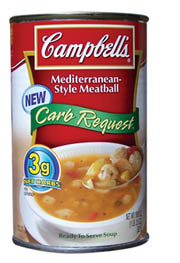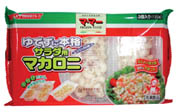
As many parents can attest, a hot bowl of soup has an abundance of healthful attributes, whether helping to battle a common cold or simply trying to warm up after a spell outside in the cold. However, researchers at Pennsylvania State University (State College, Pa.) managed to unearth a new aspect of soup's benefits, one that could be quite beneficial amid the obesity epidemic.
When incorporated into the diet, “low-energy-dense” foods (defined as water-rich, and with fewer calories per gram) such as soups, vegetables and fruits were found to be key to calorie reduction and successful longer-term weight loss. In the one-year study, subjects added two servings of soup a day as part of a reduced-calorie diet, and lost an average of five pounds more than subjects who consumed two servings of calorie-matched, higher-energy-dense snacks.
All of which must have come as great news at Campbell Soup (Camden, N.J.), the 2004 winner of the Spirit of Innovation Awards for its foodservice line of V8 soups, entrées and chilis. Setting those items apart were a pair of inventive attributes.
First, they were designed for health-conscious consumers, and each product provides eight essential vitamins and minerals. At the same time, the Away from Home line included such trendy, upscale ingredients as Portobello mushrooms and yellow curry, while remaining either vegan or, at the least, vegetarian.
Second, Campbell brought a powerful brand from a completely different category to accentuate that vegetarian aspect. V8, long a staple in beverages, helped to communicate the healthful aspects of the line.
On the retail side, Campbell's most-notable healthful efforts mirrored those of the rest of the industry--dropping carbohydrate levels. For its part, Campbell introduced the Carb Request line of hearty soups in such varieties as spicy sausage with chicken and bell pepper trio; roasted chicken and penne with garden vegetables; Mediterranean-style meatball; savory beef and mushroom medley; and chicken broccoli cheese. None of the products had more than 5g of net carbs per serving.
However, as readers probably know all too well, 2004 was not a good year to be a carb. The soup category saw reduced-carbohydrate introductions from all of the major players. General Mills' (Minneapolis) Progresso brand may not have cut carbs to quite the same level as Campbell, but it was not for a lack of trying. Progresso's Carb Monitor range of soups each had 5g to 7g of net carbs per serving, in such flavors as chicken vegetable, beef vegetable, roasted turkey vegetable, Tuscan-style meatball and chicken cheese (enchilada style).

Finding Flavor
Those latter two varieties serve as examples of another major trend impacting soups in 2004. Companies devoted increased attention to ethnic flavors. In addition to its Carb Monitor entries, Progresso's Ready-To-Serve Soups line added traditional Italian-style wedding. Although, to be fair, the line also launched such soup staples as Rich & Hearty New England Clam Chowder and Rich & Hearty Steak and Homestyle Noodles.Still, introductions did benefit from a variety of ethnic influences. In Campbell's Select Soup line, for example, the Mexican-style chicken tortilla included “mildly spicy tomato broth” with chicken, vegetables and rice, boasting such flavorful ingredients as red peppers, green chili peppers, cilantro and dried chipotle chili pepper.
However, additional new ethnic-inspired flavors were not uniquely American: Latin, South or otherwise. In fact, Lipton Cup-a-Soup (Unilever Bestfoods, Englewood Cliffs, N.J.), as part of its “great new taste!” revamp, added a distinctly Asian flare. Asian beef noodle and spicy Thai chicken joined the line, offering flavors from such sources as cilantro, red bell peppers and, oddly enough, jalapeño peppers.
Lipton did not stick solely outside the U.S. for inspiration for its revamped line of Cup-a-Soup. Tomato with croutons, spring vegetable, cream of chicken, chicken noodle and broccoli cheese were among the familiar flavors on offer. Even with its range of side dishes, Lipton balanced the adventurously flavorful with the tried-and-true.
Stand Up
Admittedly familiar to certain areas of the country, Lipton's Cajun Sides line of rice offered two varieties that some locales may regard as distinct. New Orleans style chicken and garlic butter joined Lipton's Louisiana-influenced line, both promising “mild Cajun spices.”The Cajun-influenced offering followed upon Lipton's successful Asian-flavored sides launched last year and was joined by a range of Fiesta Sides. This line of flavored rice included such varieties as smoked chipotle, taco and nacho pasta. The smoked chipotle included peppers as well as a mesquite smoked flavor and also boasted a mix of rice and orzo pasta. The taco rice, meanwhile, is another rice and pasta blend with cheese in a taco-flavored sauce.
Each of those Lipton introductions followed upon the lead of a 2003 packaging innovation which saw Uncle Ben's (Masterfoods USA, Hackettstown, N.J.) introduce ready-to-heat rice that could be microwaved in its own packaging. Another company well-known for its flavored rice dishes, Zatarain's (Gretna, La.), took a cue from these two and introduced New Orleans Style ready-to-serve rice dishes in such flavors as jambalaya rice, red beans & rice, chicken & herb rice, long grain wild rice and yellow rice.
However, the big news for companies striving to bring more-flavorful rice dishes to market may have been a scientific discovery of the gene which imparts the distinctive flavor to jasmine and basmati rice. With their discovery, researchers at Southern Cross University's Centre for Plant Conservation Genetics (Lismore, Australia) believe bland grains may be converted into tasty, healthful foods, especially considering the gene appears to be present in other grains, such as wheat, barley and pulse, possibly benefiting pasta as well, they surmise.
In the year of carb-cutting, however, pastas were not spared the Atkins-influenced wrath. Lipton Carb Options Classic Basil Pesto Pasta promised only 8g of carbohydrates and, in the midst of a particularly dismal financial year, American Italian Pasta Company (Excelsior Springs, Mo.) halved the carb content across a range of its bigger brands, including Anthony's, Luxury, Martha Gooch and R&F.
Even potatoes were not spared the carb-cull, as General Mills decided it was high time for Betty Crocker to try a South Beach way of life, although not to the extent that Kraft (Northfield, Ill.) did. Kraft actually has teamed up with the makers of the South Beach Diet to create a line of healthful food items. While Kraft's South Beach efforts will not see store shelves until this spring, however, Betty Crocker already is monitoring carbs.
Betty Crocker Carb Monitor roasted garlic mashed potatoes, for instance, slashed the carbohydrate content of the regular Betty Crocker flavor by 27%, replacing “a portion of the potato ingredients with fiber and protein” to result in 16 net carbs per serving.
For some companies, though, merely fine-tuning the potatoes was not enough, as consumers may have regarded carbs and potatoes as one and the same. For those audiences, Heritage Family Specialty Foods (Grand Prairie, Texas) presented ImiTaters. This frozen, mashed, seasoned cauliflower claimed to resemble mashed potatoes in both taste and texture, and featured such flavors as smoky chipotle, savory garlic and “the works.”
Much of the information in this article was derived from Mintel International's Global New Products Database, www.gnpd.com, 312-932-0400.
Sidebar: Going Global
While side dishes in the U.S. found themselves with fewer carbs, other countries saw gluten-free items come to the fore. San Remo (Windsor Gardens, Australia) introduced gluten-free instant lasagna sheets, as well as a spirals pasta with the same positioning. Promising an al dente taste and texture to Australian consumers, the sheets were naturally free from gluten, dairy products, eggs and yeast. Similarly, in Italy, Riso Scotti (Pavia, Italy) offered a gluten-free “pasta” that was actually 100% rice-based, as was Fat Burner gourmet spaghetti introduced in Mexico by Golden Harvest (Tlalpan, Mexico).In South Africa, a gluten-free rice added some flavorful ingredients. Health Rice from Spice and All Things Nice (Cape Town, South Africa) boasted apricots, almonds and mint.
Presenting pasta in a more-convenient manner, Nissihin Foods (Tokyo) offered Yudezu Ni Honkaku frozen pasta, which could be microwaved. Similar ambient, microwaveable and pre-cooked pasta in pouches also were seen from Masterfoods (Hackettstown, N.J.) in the form of Dolmio Express!, which debuted in New Zealand, Hong Kong and Australia.
Unibel (Brussels, Belgium) added a little flavor to Belgium's instant soup market. Under the Knorr brand, instant soup cubes were available in three varieties: curry & coco sensations, shiitake Asian and epinards & champignons (okay, spinach & mushroom).
Photos courtesy of Mintel International's GNPD
